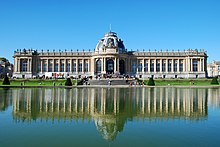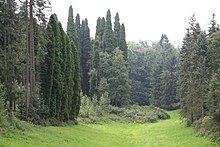Tervuren
| Tervuren | ||
|---|---|---|

|

|
|
|
|
||
| State : |
|
|
| Region : | Flanders | |
| Province : | Flemish Brabant | |
| District : | Lions | |
| Coordinates : | 50 ° 49 ′ N , 4 ° 31 ′ E | |
| Area : | 32.92 km² | |
| Residents: | 22,422 (Jan 1, 2019) | |
| Population density: | 681 inhabitants per km² | |
| Post Code: | 3080 | |
| Prefix: | 02 | |
| Mayor: | Jan Spooren ( N-VA ) | |
Local government address : |
Administratief Centrum, Brusselsesteenweg 13, 3080 Tervuren |
|
| Website: | www.tervuren.be | |
Tervuren (also Tervueren in French ) is a Belgian municipality in the province of Flemish Brabant in Flanders . The municipality on the eastern city limits of Brussels includes the districts of Duisburg , Tervuren, Vossem and Moorsel .
Tervuren had a total population of 22,422 on January 1, 2019. With an area of 32.92 km², the population density in the municipality is 681 inhabitants / km². The official language in Tervuren is Dutch . Due to the proximity to Brussels and the British School in Tervuren, an international minority has formed, whose members mainly come from the states of NATO and the European Union .
history
According to Christian tradition, Tervuren is the place called Fura , where St. Hubertus of Liège died in 727 . But this is not historically proven. A first historical document from 1213 tells of a wooden fortress that was built on this site by Henry I , Duke of Brabant . This fortress was expanded into Tervuren Castle, which was the residence of the Dukes of Brabant in the 14th and 15th centuries. In 1782, however, the castle was destroyed.
In the 1940s and 1950s, the flourishing Tervuren was a great attraction for the artists of the era. The Duke of Brabant had his summer residence here. The beautiful surroundings with a rural character, consisting of extensive parks, offered many motifs. The Auberge du Renard was a meeting place for the artists, some of whom settled in Tervuren.
Until 1959, Tervuren was the terminus of an electrically operated railway. The station opposite the Royal Museum for Central Africa was demolished in 1964. The goods shed was converted into a pub called Spoorloos Station (German: Gleislose Bahnhof ; Spoor also means "track", meaning that it has disappeared without a trace).
Tervuren is now one of the wealthiest communities in Belgium. It is connected to Brussels via the Tervurenlaan (French: Avenue de Tervuren , today's N3). This eleven kilometer long double-lane avenue was laid out by Leopold II on the occasion of the world exhibition in 1897. It led from downtown Brussels directly to the Colonial Palace (later the Colonial Museum) and is still one of the longest avenues in Europe.
Tram line 44 of the Brussels Transport Authority (MIVB / STIB) runs along the boulevard as a connection between the Montgomery metro station and Tervuren. Historic vehicles from the Woluwe Tram Museum also run on the scenic route in summer.
On January 1, 1977, the previously independent municipalities of Duisburg and Vossem were incorporated into Tervuren.
In 2003, the Brussels suburb was the scene of the Pralinen Summit, a security policy summit for Belgium, Germany, France and Luxembourg.
coat of arms
Description: In silver, a blue, blue armored and also tongued and so crowned lion .
Community structure
The municipality of Tervuren comprises four settlement centers:
- Tervuren with its old town
- Moorsel, has always been politically part of Tervuren
- Duisburg, in the Middle Ages an independent rule, then an independent municipality, since 1977 to Tervuren
- Vossem, a village in the valley of the Voer river, has been part of Tervuren since 1977
Culture
Tervuren is particularly known for its Royal Central Africa Museum ( Koninklijk Museum voor Midden-Afrika ), which is located just north of Tervuren Park. The main exhibition of the museum, shown since 1957, focuses largely on the Democratic Republic of the Congo , a former colony of Belgium. However, East, Central and West Africa are also taken into account. The museum was closed on December 1, 2013 due to the need for a thorough renovation and was reopened in 2018 with a new concept.
In the center of the parish is the Gothic "Sint-Jan Evangelist kerk" (German Church of the Evangelist John ). It was built in the 13th century. The side aisles date from the 14th century. The rood screen was built in 1517 by the Keldermans brothers. The current entrance, which served as the basis for a newer gate, dates from 1779. In the church are the tombs of the three successive Dukes of Brabant Anton of Brabant († 1415), John IV of Brabant († 1427) and Philip of Saint-Pol († 1430).
There is also a library in Tervuren (Gemeentelijke Openbare Bibliotheek Tervuren, GOBT) with 43,300 books and 886 DVDs. Most of the literature (at least 75%) is in Dutch according to Flemish legislation.
Tervuren is surrounded by two large parks. To the east is the Park van Tervuren , which is crossed by a canal and dominated by several connected lakes. The Sonian Forest is located in the southwest of the city and looks more natural. Many of the trees and shrubs in the complex were imported by Napoléon Bonaparte from countries he had conquered.
The Arboretum Tervuren is noteworthy , where 460 important tree species of the northern temperate zones and the Andes grow on 100 hectares in 40 geographically divided plots. The arboretum adjoins the park of Tervuren.
Town twinning
Since 2003 there has been a town partnership with the German municipality of Kloster Lehnin in Brandenburg .


